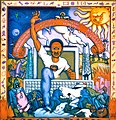
An injury to one is an injury to all is a motto popularly used by the Industrial Workers of the World (IWW). In his autobiography, Bill Haywood credited David C. Coates with suggesting the phrase as a labor slogan for the IWW. [1] The slogan reflects that the IWW is "One Big Union" and organizes many different types of skilled and unskilled workers. Since its adoption by the IWW, it has been used by a number of other labor organizations and appears in protest signage.


